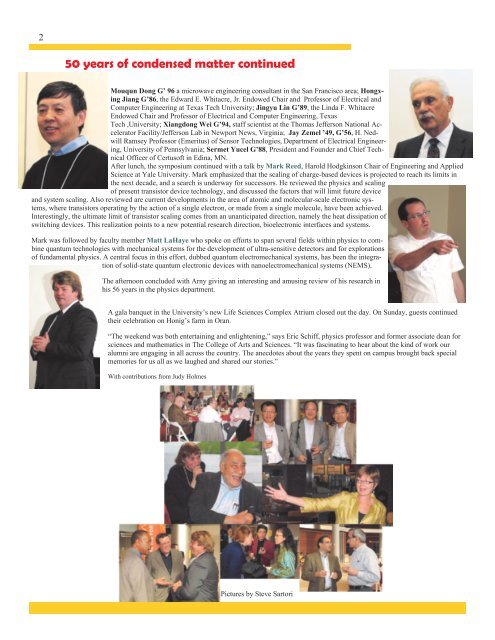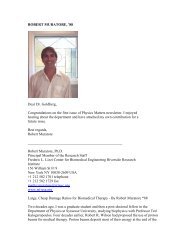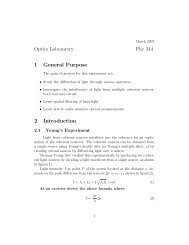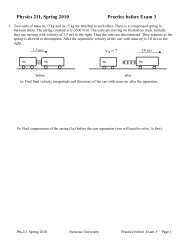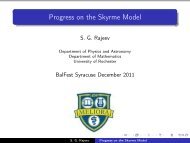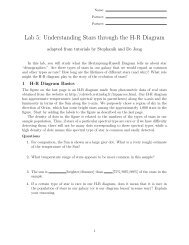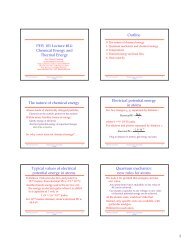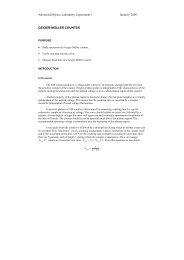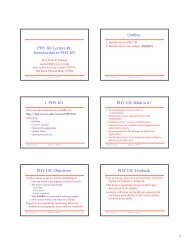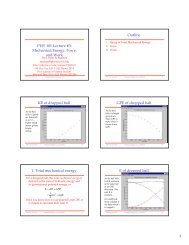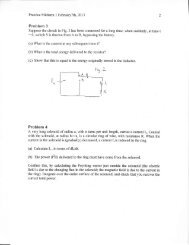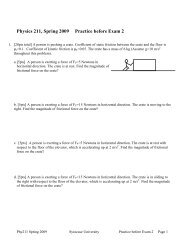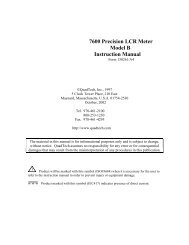Volume 5 - Physics - Syracuse University
Volume 5 - Physics - Syracuse University
Volume 5 - Physics - Syracuse University
Create successful ePaper yourself
Turn your PDF publications into a flip-book with our unique Google optimized e-Paper software.
2<br />
50 years of condensed matter continued<br />
Mouqun Dong G’ 96 a microwave engineering consultant in the San Francisco area; Hongxing<br />
Jiang G’86, the Edward E. Whitacre, Jr. Endowed Chair and Professor of Electrical and<br />
Computer Engineering at Texas Tech <strong>University</strong>; Jingyu Lin G’89, the Linda F. Whitacre<br />
Endowed Chair and Professor of Electrical and Computer Engineering, Texas<br />
Tech ,<strong>University</strong>; Xiangdong Wei G’94, staff scientist at the Thomas Jefferson National Accelerator<br />
Facility/Jefferson Lab in Newport News, Virginia; Jay Zemel ’49, G’56, H. Nedwill<br />
Ramsey Professor (Emeritus) of Sensor Technologies, Department of Electrical Engineering,<br />
<strong>University</strong> of Pennsylvania; Sermet Yucel G’88, President and Founder and Chief Technical<br />
Officer of Certusoft in Edina, MN.<br />
After lunch, the symposium continued with a talk by Mark Reed, Harold Hodgkinson Chair of Engineering and Applied<br />
Science at Yale <strong>University</strong>. Mark emphasized that the scaling of charge-based devices is projected to reach its limits in<br />
the next decade, and a search is underway for successors. He reviewed the physics and scaling<br />
of present transistor device technology, and discussed the factors that will limit future device<br />
and system scaling. Also reviewed are current developments in the area of atomic and molecular-scale electronic systems,<br />
where transistors operating by the action of a single electron, or made from a single molecule, have been achieved.<br />
Interestingly, the ultimate limit of transistor scaling comes from an unanticipated direction, namely the heat dissipation of<br />
switching devices. This realization points to a new potential research direction, bioelectronic interfaces and systems.<br />
Mark was followed by faculty member Matt LaHaye who spoke on efforts to span several fields within physics to combine<br />
quantum technologies with mechanical systems for the development of ultra-sensitive detectors and for explorations<br />
of fundamental physics. A central focus in this effort, dubbed quantum electromechanical systems, has been the integration<br />
of solid-state quantum electronic devices with nanoelectromechanical systems (NEMS).<br />
The afternoon concluded with Arny giving an interesting and amusing review of his research in<br />
his 56 years in the physics department.<br />
A gala banquet in the <strong>University</strong>’s new Life Sciences Complex Atrium closed out the day. On Sunday, guests continued<br />
their celebration on Honig’s farm in Oran.<br />
“The weekend was both entertaining and enlightening,” says Eric Schiff, physics professor and former associate dean for<br />
sciences and mathematics in The College of Arts and Sciences. “It was fascinating to hear about the kind of work our<br />
alumni are engaging in all across the country. The anecdotes about the years they spent on campus brought back special<br />
memories for us all as we laughed and shared our stories.”<br />
With contributions from Judy Holmes<br />
Pictures by Steve Sartori


